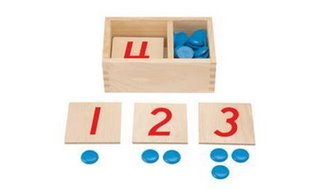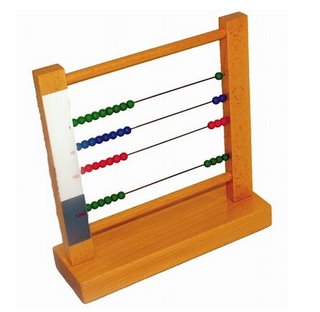Let’s talk math, shall we? I believe that Montessori math is just about the best thing going. Sure, there are lots of other educational methods that have wonderful ways of teaching language, science, history, art, and music, but for me the Montessori math materials are truly unique.
What makes them unique? First of all, the introductory materials are all hands-on rather than abstract. Second, they are sequential – each one builds upon the one before. Third, they contain many similar elements (colors for hierarchies, beads, etc.) that enable the child to master new work quickly.
Math begins in infancy. It can be something as simple as mom or dad counting baby’s fingers or toes. In early childhood, children learn to count and start to become aware of patterns and sequences. As they move into the elementary years, they begin to understand how numbers interact with each other, as well as notice how math is such a constant presence in our lives.
Sneaking Math into Sensorial
The very first Montessori math materials are actually in the Sensorial area of the classroom; they include the Pink Tower, Brown Stair, Red Rods, and Cylinder Blocks. At first glance, these materials may not seem to be mathematical in nature. A closer look reveals that each of the materials is based on the number 10: ten cubes, ten rods, ten cylinders.
This emphasis on base 10 (or the decimal system, which is the basis of modern math) is one of the less-apparent features of these materials. The obvious points of interest for the Sensorial materials are coordination, fine and gross motor skills, following directions, sequencing, and grading by size. The fact that Montessori decided to incorporate the decimal system into these materials is a brilliant way to introduce the idea of quantity early on.
Humans learn best through repetition, and respond favorably to familiar concepts and objects. So, it makes sense to use one of the Sensorial materials as the first true Math material. By alternating blocks of blue on the red rods, the child becomes aware of the numerical properties of the work. The alternating colors enable the child to see how each rod increases by one length. Very simple math calculations can be performed with the red and blue rods, also. It’s very easy to see how the “2” rod and the “3” rod combine to equal the “5” rod.
It’s the Concept Behind the Counting
Just as a young child can learn the Alphabet Song without having any idea of the sounds the letters make, a child often learns to count to 10 (or 20, or 100) without actually understanding what the words mean. There are actually three separate concepts that must be addressed: number, quantity, and the relationship of the two together.
 One of the best ways for a child to learn all three of these concepts is with the cards and counters. This classic work is fun for kids to do, and has several further applications besides simply counting out the correct number of counters, for instance, learning about odd and even numbers. (See picture: cards and counters).
One of the best ways for a child to learn all three of these concepts is with the cards and counters. This classic work is fun for kids to do, and has several further applications besides simply counting out the correct number of counters, for instance, learning about odd and even numbers. (See picture: cards and counters).
The golden bead material is extremely important, and indeed all the bead materials are versatile and can be used for everything from simple addition and subtraction to complicated long division. A child who works with the beads in 3-6 will happily find that the same beads, strung on wires, comprise the bead frames which make more complicated problem solving possible.
A Place for Rote Learning
What do I remember about math when I was growing up? Only two things: 1) that I didn’t like it, and 2) how boring it was to memorize the multiplication tables. I would definitely have benefited from the hands-on nature of the Montessori materials, and also from the focus on process rather than simply finding the correct answer.
Still, at some point children do need to commit their “math facts” to memory. There are several ways to do this that are fun and entertaining. Some favorites include extensions like picking up a handful of equations from one of the equation boxes and throwing them back in the box while saying the answer. Kids love to play this game together. What I’ve observed is that if children use the Montessori math materials on a regular basis, they often memorize their math facts without actually setting out to do so.
For some children, mastering math facts is a challenge even in Montessori. They may simply need more rote and repetition than other kids do. In these cases, flashcards and even learning tools like CDs that teach math facts set to music are very helpful.
What About Workbooks?
Is there are place for worksheets and workbooks in Montessori math? Surprisingly, I do believe there is. However, I think they should be used sparingly and only for concepts that aren’t covered in the traditional materials. For instance, time and money concepts, patterning and sequencing, and word problems are all areas where workbooks can be used to “fill in the gaps” that might otherwise occur.
Also, if children will be required to take standardized tests, I believe they should have the chance to use workbooks to become acquainted with testing conventions like multiple choice, fill-in-the-blank, and following written directions.
The Passage to Abstraction
Many times people ask me about the “path to abstraction” and whether or not kids are hindered by doing so many concrete math materials first. Every observation indicates the opposite: kids are better able to understand abstract mathematical concepts because they have first handled the actual materials.
When does the passage to abstraction begin? In my experience, it starts in stages during the 6-9 age period. A child who still needs the materials to do multiplication may already have begun to internalize the concepts of addition and subtraction and not need the materials for those processes anymore. In other words, there’s no one moment when a child moves from concrete to abstract.
 It also starts gradually, and is built into the materials themselves. For instance, a child who has been using the small and large bead frames (with colored beads for units, tens, hundreds, and thousands) will then move to the golden bead frame, which is similar except that the color hierarchies are removed. (See picture: small bead frame).
It also starts gradually, and is built into the materials themselves. For instance, a child who has been using the small and large bead frames (with colored beads for units, tens, hundreds, and thousands) will then move to the golden bead frame, which is similar except that the color hierarchies are removed. (See picture: small bead frame).
Need More Info?
I highly recommend the math album authored by Sister Mary Motz, my Montessori trainer. It’s available through Nienhuis, and I won’t link to it because they change their links all the time. If you go to Nienhuis and search for “mary motz”, you will find the Montessori Matters Math album, as well as other albums authored by her. It’s just about the most thorough, best written Montessori math album out there.
Thank you to Alison’s Montessori for the pictures of the math materials!

